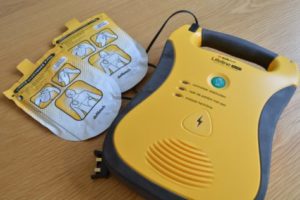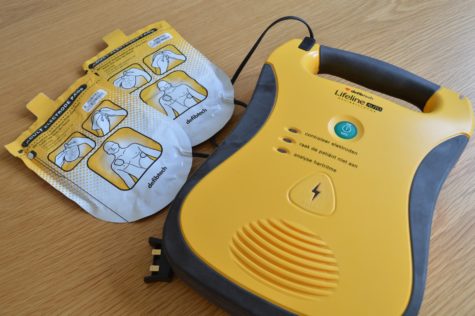COVENTRY, England — It’s lunchtime at the office, and in the cafeteria Dave is barely getting through a killer joke because he is laughing so hard at himself.
He has his tie thrown over his shoulder, and his face is bright red. The whole table is waiting for the punchline. Suddenly his laughter stops and he puts a hand to his chest. Your coworkers don’t realize what is happening and neither do you at first. Dave stands up, knocking over his chair, then drops to the ground. He barely manages to get out the words, “I think I’m having a heart attack.”

Looking around for help, a sign that someone knows what to do, you at first don’t notice the green box that’s always been mounted on the wall next to the vending machine. Someone is calling 911.You’re half listening to them talking to the dispatcher and half watching Michelle kneeling down and loosening his tie, saying his name over and over again trying to get a response.
You still aren’t sure what to do and it seems like forever has gone by when you finally notice the heart shape on the green box. There is a defibrillator inside you realize — the type of device doctors use in movies when they shout “Clear!” and shock the heart attack victim back to life.
It seems so simple when they do it, but suddenly you are full of doubt as you rush to take it out of the box.
“Does anyone know how to use this thing?” you ask the panicked room.
“I don’t know, he’s not breathing,” Michelle says. “Should we try it?”
While such automated external defibrillators (AEDs) are designed to be used by untrained members of the public — the devices give clear instructions on what to do and how to use them once opened — a new analysis of 68 existing studies out of University of Warwick suggests it’s all too likely that in such a situation it wouldn’t end up being used.
Though it could likely save Dave’s life if it was.
Indeed, when combined with CPR, studies showed heart attack victims that had a public access AED used on them were nearly twice as likely to survive as those that only received CPR.
“However the number of cases when a public access defibrillator is used is very low – just 0.15-4.3% of cardiac arrests that occur outside of hospitals,” says study author and professor of critical care medicine Gavin Perkins in a press release.
Perkins, who alongside colleagues performed the new analysis of existing international studies on AED use, found that several studies showed many people don’t even know what an automated external defibrillator (AED) is, let alone where to find one and how to use it in an emergency.
While public AEDs are suitable to be used by untrained members of the public — and many even play audio instructions — the researchers found many people lack the confidence to use them and many fear further harming heart attack victims.
The researchers said it also too common for AEDs to be poorly accessible or not available at all. What’s more, they found that AED locations are often not even known by emergency services or those giving AED training. And, it seems, such training is also too rare, as most people were found to have never received instructions on defibrillator use.
“Investment in more AEDs is great but it’s at least as important to maximize use of existing defibrillators,” says professor Theo Arvanitis, another of the study’s analysts.
That said, the researchers noted that when new defibrillators are purchased, it is often through donations or fundraising, rather than an institution or business buying them outright. Beyond cost concerns, other reasons facilities reported for being reluctant to purchase AEDs included:
- Liability Concerns
- Belief an AED isn’t necessary
- Lack of responsible individual to do the purchasing
- Belief that local emergency services were enough
- Proximity to a nearby hospital
But perhaps the most surprising finding out of the studies analyzed was the mention of one study which found only 1 out of 206 defibrillators tested in South Korea’s second largest city, Busan, was operable and ready for use. A large and modern city, this study has worrying implications for the state of AEDs elsewhere in the world.
Arvanitis said another issue with getting to working AEDs was that many public defibrillators are kept inside buildings that are closed after business hours.
Attempting to do something about these availability issues, a research team in Sweden is currently testing out the ability to for drones to quickly deliver defibrillators to the location of heart attack victims. While there are many barriers to be overcome, the initial results of these tests have been promising, with drones delivering AEDs much faster than an ambulance could arrive.
In that study, researchers likewise worried that bystanders would be reluctant to use the AED before emergency medical services arrived.
“We would also like to see the message put out that these devices can be used without training,” Arvanitis said. “However our study found that those with training were more likely to use an AED, so training is important too.”
The analysis of existing international AED studies was published recently in the European Heart Journal – Quality of Care and Clinical Outcomes.

Comments
Comments are closed.